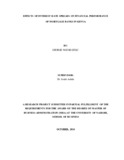| dc.description.abstract | It is widely believed that fluctuations of market interest rates exert significant influence
on the activities of commercial banks. The effect of interest rate spread changes on
banks’ profitability is shown to be asymmetric with the effect originating from lending
rates being greater than those of deposit rates. The objective of this study was to
determine the relationship between interest rates spread and the performance of mortgage
banks in Kenya. This was a census study of all registered 43 commercial banks in Kenya
and relied heavily on documentary secondary data for 5 year study period (2009-2013).
The study found that interest rates spreads are higher for larger banks than for medium
and small banks. On average, small banks have lower spreads. This could possibly be due
to the fact that small and low-capitalized banks find it relatively difficult to raise funds
and have to increase their deposit rates to attract funds and compensate for the perception
that they are more risky relative to large, more liquid, well capitalized banks that are
perceived to be ‘too-big-to-fail’. If the higher spreads are merely interpreted as an
indicator of inefficiency, one can easily be tempted to conclude from the positive
relationship between bank size and interest rate spreads that big banks are less efficient,
which may not necessarily be the case. The results are not surprising given that big banks
are associated with market power—they control a bigger share of the market both in
terms of deposits and loans and advances. The study concludes that there is a positive
linear relationship between interest rate spread and financial performance measured as
return on assets (ROA) and return on equity (ROE). There are also statistically significant
positive relationships between market power, liquidity, operating efficiency and return on
assets (ROA) and return on equity (ROE). The study recommends that a study should be
replicated in other commercial banks and microfinance institutions across East Africa and
beyond to validate such results. | en_US |

